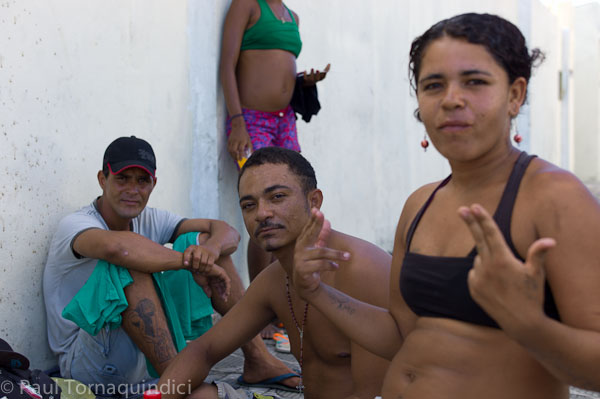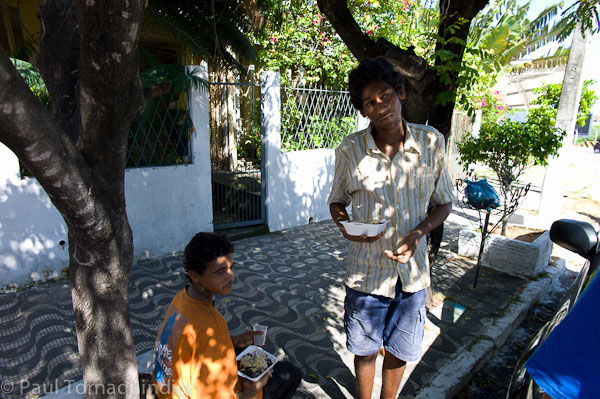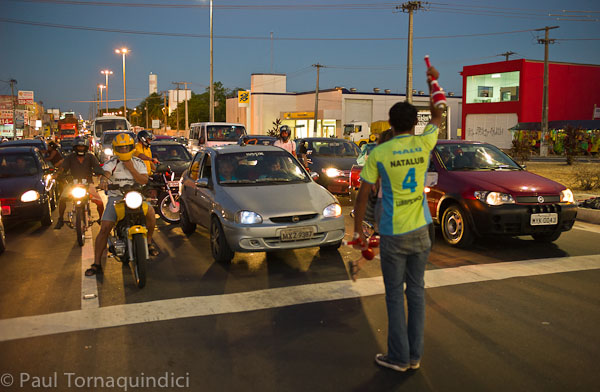
In 1989, 192 countries ratified the Convention on the Rights of the Child at the United Nations, making it the most ratified human rights convention in history (UNICEF). This not only established the basic human rights of children up to the age of 18, but it also holds each signatory to a higher level of responsibility in ensuring that these rights are upheld and protected (UNICEF). This shows that the global community recognizes such seemingly insurmountable problems, and is willing to set, and rise to, a new standard of ethical law concerning this issue.
So how can it be that, in Brazil, two million children between the ages of 10 and 15 have been forced into prostitution (Jubilee Action Organization), 4.2 million children are working in abusive conditions (JAO), and in Rio de Janeiro alone, five to six children are assassinated every day (JAO)? These gross injustices are committed because the Brazilian government lacks the motivation to do anything to help these children. Facts such as these shed light on the awful reality that the rights that were so honorably ratified by the United Nations are flagrantly ignored in many places. There is little or no incentive to help millions of hurt and homeless children, especially in today’s economy. Even Brazilian society labels them as outcasts; they aren’t worth the trouble. So rather than being a matter of concern that hundreds of thousands of them die every year, their deaths are seen as an improvement to society.
Brazil, like many other areas of the world, is characterized by a huge gap between the rich and the poor. The Jubilee Action Organization estimates that 50% of the nation’s income is controlled by the richest 1% of the country, and the poorest 50% have to survive on just 10% of the country’s income. Since the U.S. Central Intelligence Agency reported the Brazilian GDP to be $1.34 trillion in 2001, this means that about 1.74 million of the richest people in Brazil controlled around $384,000 each, while roughly 872,000,000 of the poorest people in Brazil controlled a little over $153 each. This assumes that every person in the poorest 50% had an equal share, which we know to be false. The poorest of these people are generally children who are caught in what is referred to as the “poverty cycle.” Essentially, poor parents cannot afford to send their children to school, so the children cannot get well-paying jobs. They generally drop out of school and take low-wage work (legal or illegal) and can rarely improve their work status. These kids then grow up and have children of their own, who follow in their parents’ footsteps. It is this that drives teeming hordes of children out onto the streets every year. They have nowhere else to turn.
Poverty like this has devastating effects, particularly on children. It is the springboard for prostitution, preventable disease, AIDS, illiteracy, child labor, high infant mortality rates, teenage pregnancy, and social injustice, to name a few (JAO). Thus, the problem is compounded and becomes self-perpetuating. Children who have no other alternatives will turn to crime as a means to support themselves. This is why so many girls become prostitutes — nearly 500,000 according to the Brazilian Center for Childhood and Adolescence (Oliveira). It is also the reason that thousands of kids end up panhandling or stealing to get their next meal. These conditions increase the number of teenage pregnancies, the percentage of kids with AIDS, and the already high infant mortality rates. All of these problems are born from, and aggravated by, the never-ending cycle of poverty.
Another deadly catalyst looms in the background of all of this. Behind the poverty and crime lies a network of drug trafficking and abuse that affects nearly every child living on Brazil’s streets. In 1992, a study documented the use of drugs in 150 street boys between the ages of 10 and 17, and revealed that 100% of them were involved in drug abuse (J. Inciardi and H. Surratt, 1997). This is not an isolated occurrence by any means. This same article tells of two other studies. In a survey of 119 children in Sao Paulo, 45% were classified as “heavy drug users, indicating the use of up to three drugs a day.” In Belo Horizonte studies show that, “84% of the children living full time in the street had histories of illegal drug use.” The problem affects boys and girls of all ages in nearly every city across Brazil. The most commonly used inhalant drug is cobbler’s glue, but there is also widespread use of marijuana, cocaine, Valium, Rohypnol, and coca paste (J. Inciardi and H. Surratt, 1997) — with coca paste being one of most dangerous drugs. Inciardi and Surratt also stated, “In addition to cocaine, [cocoa] paste contains traces of all the chemicals used to initially process the coca leaves — kerosene, sulfuric acid, methanol, benzoic acid, and the oxidized products of these solvents, plus any number of other alkaloids that are present in the coca leaf.”

How do children so young end up abusing drugs like these? One reason may be that gang leaders, pimps, and drug syndicates, use drugs as a means to keep the children reliant on them. If they are addicted to what the crime lords provide, then the crime lords have complete control over them. They can use the kids for whatever they need them for, because they know they will do anything for their next high. However, there is another more plausible cause for most of the drug abuse cases in Brazil. Many children choose to abuse drugs, not out of addiction, but as a means of forgetting. Inciardi and Surratt write that, “Many street youths in Rio de Janeiro see their use of inhalants, cocoa paste, marijuana, Rohypnol, and other drugs, as an escape — a way to dull their hunger and facilitate acts of prostitution and other crimes.” What children on the streets of Brazil suffer every day is more than anyone can imagine. The things that they must do to live through one day are so unimaginable, so horrible, that they turn to the only thing that offers them release for a few hours. One young street girl put it this way:
When I was prostituting at the boarding house, my father would go there and want to pay me to have sex with him. I would never do it and every time he would leave, I would smoke a lot of marijuana to try and forget the things that he would say. (J. Inciardi and H. Surratt, 1997)
Unfortunately, this kind of crime and drug abuse is the source of the stigma that most Brazilian citizens associate with street children. Nancy Scheper-Hughes and Daniel Hoffman went out into the streets of Recife to ask ordinary people what a street child (“menino de rua”) was. The following is one response:
‘Is any kid on the street without an adult a street kid?’ In exasperation, the friend
replied, ‘Look, they steal and they sniff glue. That’s why they’re street kids.’
Those among the middle and upper class society in Brazil commonly make these associations. They see street kids as nothing more than pests that need an exterminator. This attitude toward them then facilitates crime against these children, and allows it to go overlooked and unpunished. Perhaps the most well known case of this is the Candelaria massacre. On July 23, 1993, several off-duty Brazilian police drove by The Candelaria, a Roman-Catholic church, and fired on several street children who had gathered there for safety. Eight kids were killed ranging in age from 11 to 20 years old. Many others were injured. Unfortunately, only one of the alleged perpetrators was convicted and sent to prison, despite the fact that there were many others who were tried for the murders. These hate crimes committed against street children are commonly considered a sort of “social cleansing.” (J. Inciardi and H. Surratt, 1997) Vigilante groups and police squads are the most common groups that seek to harm these children. The police squads in particular are called “Esquadron de Muerte” or “Death Squads.” (J. Inciardi and H. Surratt, 1997) “The victims were easily recognized. Their hands were always tied behind their backs, their tongues cut out, and a crudely drawn skull and cross-bones were left on the corpse with the initials ‘E.M.’ — ‘Esquadron de Muerte’ — appended.” (J. Inciardi and H. Surratt, 1997) These are most likely meant as messages to the community. These groups have nothing to stop them, and they will continue to kill as they please. This is why we see statistics that tell us that five to six children are assassinated every day on the streets of Rio (JAO).
So what is the Brazilian government doing to help these kids? Unfortunately, the answer to that is “very little.” The government has, on rare occasions, expressed concern over this growing problem and established programs to aid street children. However, these programs and institutions are generally makeshift and improperly managed. Lori Procopio, who moved to Brazil with her husband and children to work with street children says, “The government facilities for abandoned or orphaned children are so bad that the kids are petrified of ‘being taken care of’ by the government.” Even the facilities that are somewhat effective are severely limited by the lack of resources. There are just too many children to help, and not enough time, people, or resources to help them all. It is said about these programs that,
In addition to teaching basic hygiene, literacy, and business skills, the general program approach is to instill self-reliance and empowerment so that the children will find solutions to their problems. However, it would appear that this street educator model is overly ideological, and fails to deal with the immediate physical and safety needs of street children. (J. Inciardi and H. Surratt, 1997)
It is important to note that of the three types of intervention strategies, correctional, rehabilitative, and outreach (J. Inciardi and H. Surratt, 1997), correctional is the strategy most employed by the Brazilian government. The government creates “institutions” and “correctional facilities” that are little more than holding cells for kids that the police pick up off of the streets. Children are often in these facilities for only a matter of days before being released back onto the streets, having received no aid of any kind. What makes this even worse is that during their stay, they are trapped in tiny cells often without any food or water. Inciardi and Surratt say, “Conditions in these facilities have been described as both crowded and abusive” Nancy Scheper-Hughes and Daniel Hoffman point out that “The seemingly far-fetched rumors of street kids kidnapped for overseas adoption or mutilated for their organs co-exist with an active round-up of street urchins, thousands of whom “disappear” each year into state-run reform facilities that are viewed with suspicion and horror by shantytown residents.” Unfortunately, this represents much of what the government has done for street children. They are unmotivated to do anything more, simply because they do not see helping street children as an acceptable use of government time and resources.

Despite the government’s lack of organization and care, there are those who seek to help the kids that live on the unforgiving streets. Non-Government Organizations (NGOs), or “on-gies” as they are called in Brazil (Lori Procopio) are often the only sources of true aid for street children. Mrs. Procopio says that, “Most of these NGOs are Christian-based. The God that says, ‘Even when your mother and father abandon you, I will take you up’ the God that is ‘the Father of the fatherless’” is the only hope that these children have. Organizations like The Jubilee Action Organization, Task Brazil, and countless other smaller, localized aid groups are continuously giving and helping, trying to get as many children off of the streets as they can. These then, are the only things that give children hope and a possibility of escape from an otherwise doomed existence on the streets of Brazil.
It is clear that children that live on the streets of Brazil are some of the most unfortunate children in the world. They are subjected to extreme conditions stemming from poverty, which are worsened by the Brazilian public’s general distaste for them. The government has little or no concern for these children, and is often the main antagonist in the lives of street kids. Certainly, the only hope that these children have comes from localized aid groups and NGOs that are established in foreign developed nations like the US, Australia, China, and countless European nations. It is therefore necessary that these groups be supported wholeheartedly, because they are the reason that thousands of children have hope.